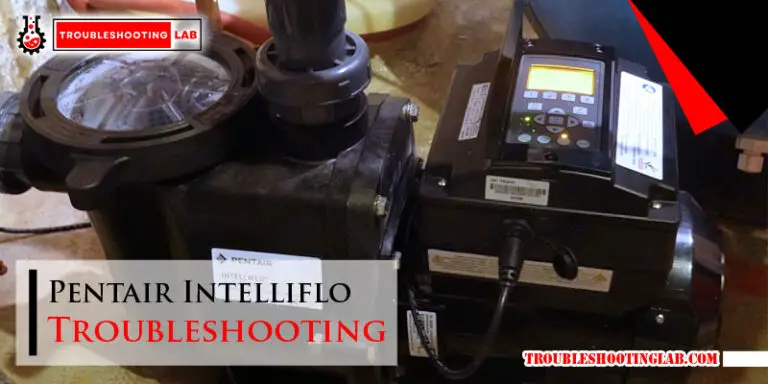Ecm Motor Troubleshooting Tips: Diagnosing Motor Issues
Ecm motor troubleshooting involves checking the system basics and confirming the correct thermostat settings before proceeding with any further troubleshooting. Additionally, it is important to understand that ECM motors are factory-programmed and cannot be programmed in the field.
The manufacturer programs the motor based on how it will be used, whether it’s to maintain torque, airflow, or speed. ECM motors are the most efficient FHP motors and do not use capacitors. To troubleshoot ECM motors, it is recommended to refer to manuals and guides provided by manufacturers for setup, programming, and troubleshooting instructions.
Familiarizing oneself with ECM motors is also crucial due to new energy rating laws.

Understanding Ecm Motors
ECM (Electronically Commutated Motor) motors are a type of motor that offers several advantages over traditional motors. They are commonly used in HVAC systems as well as other applications that require precise control over motor speed and torque. In this section, we will explore what ECM motors are, how they work, and the benefits of using them.
What Are Ecm Motors?
ECM motors, also known as variable-speed motors, are advanced motors that use advanced technology to provide greater energy efficiency and control. Unlike traditional motors, which operate at a fixed speed, ECM motors can adjust their speed and torque based on the specific needs of the system they are powering.
These motors are often used in HVAC systems to control the speed of the air handler blower motor. They can also be found in appliances like refrigerators, washing machines, and even electric vehicles. ECM motors are usually more expensive than traditional motors, but their energy savings and performance benefits make them a worthwhile investment.
How Do Ecm Motors Work?
ECM motors use a specialized control module that adjusts the motor’s speed and torque based on input from sensors. These modules use algorithms to constantly monitor and adjust the motor’s performance to optimize energy efficiency and performance. The control module communicates with the motor using digital signals, allowing for precise control over the motor’s operation.
One of the key features of ECM motors is their ability to vary the motor’s speed. This allows the motor to operate at a lower speed when less power is required, resulting in energy savings. The motor’s speed can be adjusted in real time to respond to changes in system demand, ensuring that the motor is always operating at its most efficient level.
Benefits Of Using Ecm Motors
There are several benefits to using ECM motors in various applications:
- Energy efficiency: ECM motors are much more energy-efficient compared to traditional motors. By adjusting the motor’s speed based on the system’s needs, ECM motors can provide significant energy savings.
- Precise control: ECM motors offer precise control over motor speed and torque. This allows for optimized performance and improved system efficiency.
- Reduced noise: ECM motors tend to operate more quietly compared to traditional motors. This can be particularly important in residential and commercial environments where noise levels are a concern.
- Improved comfort: With their ability to adjust speed and torque as needed, ECM motors can provide a more consistent and comfortable environment.
- Extended motor life: ECM motors are designed to operate at lower speeds for longer periods, resulting in reduced wear and tear on the motor. This can extend the motor’s lifespan and potentially reduce maintenance and replacement costs.
In conclusion, ECM motors are a modern and efficient alternative to traditional motors. They offer energy savings, precise control, reduced noise, improved comfort, and extended motor life. As a result, ECM motors have become increasingly popular in HVAC systems and other applications that require reliable and efficient motor performance.
Common Ecm Motor Issues
ECM (Electronically Commutated Motor) motors are widely used in HVAC systems due to their efficiency and versatility. However, they can experience problems that may affect their performance. In this section, we will discuss some of the most common ECM motor issues and how to troubleshoot them.
Motor Not Starting Or Turning On
If your ECM motor fails to start or turn on, there could be several reasons for this issue. Here are some troubleshooting steps to consider:
- Check the power supply. Verify that the motor is receiving power by checking the electrical connections and fuses. Ensure that there are no loose or damaged wires.
- Inspect the control module: The control module of the ECM motor plays a crucial role in its operation. Check for any signs of damage or malfunction. If necessary, consult the manufacturer’s manual for specific troubleshooting steps.
- Test the motor capacitor: Though ECM motors do not use capacitors, it is still worth checking if there are any associated components that may be causing the issue. Consult the manufacturer’s manual for guidance on testing and replacing any faulty parts.
Motor Running At A Lower Or Higher Speed Than Expected
If your ECM motor is running at a speed that is lower or higher than expected, follow these troubleshooting steps:
- Check the control signals. Incorrect control signals can cause the motor to operate at the wrong speed. Test the signal wires and ensure that they are properly connected and transmitting the correct signals.
- Verify the programming: ECM motors are factory-programmed based on the HVAC equipment they are installed in. If the motor is not operating as expected, it may be due to incorrect programming. Consult the manufacturer’s manual or contact their technical support for guidance on reprogramming the motor.
- Inspect the motor control module. The control module of the ECM motor may be responsible for speed control. Check for any damages or malfunctions and follow the manufacturer’s troubleshooting guidelines.
Motor Making Unusual Noises
If your ECM motor is producing unusual noises, it may indicate a mechanical or electrical problem. Follow these troubleshooting steps:
- Inspect the motor assembly: Check for any loose or damaged components, such as fan blades, bearings, or housing. Tighten any loose parts or replace any damaged ones.
- Check for debris. Foreign objects inside the motor assembly can cause noise. Clean the motor and remove any debris or obstructions that may be interfering with its operation.
- Inspect the motor control module. A faulty control module can also contribute to unusual noises. Examine the module for any signs of damage or malfunction and take appropriate action.
Motor Overheating
Overheating is a common issue with ECM motors and can lead to premature failure. Follow these troubleshooting steps:
- Check the motor’s temperature. If the motor feels excessively hot to the touch, it may be overheating. Ensure that there is proper ventilation around the motor and that it is not obstructed.
- Inspect the motor assembly. Check for any signs of blocked airflow, such as a dirty or clogged air filter. Clean or replace the filter if necessary.
- Verify proper voltage: Insufficient or fluctuating voltage can cause the motor to overheat. Use a voltmeter to measure the voltage and ensure that it matches the manufacturer’s specifications.
If you are unable to resolve the issue with your ECM motor after performing the troubleshooting steps mentioned above, it is recommended to contact a professional HVAC technician for further assistance.
Troubleshooting Ecm Motor Issues
If you’re experiencing problems with your ECM (electrically commutated motor) and need to troubleshoot the issue, you’re in the right place. ECM motors are known for their energy efficiency and reliability, but like any other mechanical component, they can encounter problems from time to time. In this guide, we will walk you through the troubleshooting process and help you identify and resolve common ECM motor issues.
Checking For Power Supply Issues
Before diving into more complex troubleshooting steps, it’s crucial to check the power supply to the ECM motor. A malfunctioning power supply can often be the culprit behind motor problems. Use a multimeter to measure the voltage at the motor terminals. It should match the voltage specified by the manufacturer. Ensure that there are no loose or damaged wires in the power supply circuit. If the voltage is significantly lower or higher than the specified range, you might have a power supply issue that needs to be addressed.
Testing The Motor For Proper Voltage And Current
Once you’ve verified the power supply, the next step is to test the motor itself. Start by disconnecting the motor from the power supply. Use a multimeter to measure the voltage and current at the motor terminals while it’s running. Compare the readings with the specifications provided by the manufacturer. If the voltage or current is outside the recommended range, it could indicate a problem with the motor windings or control module. Make sure to note down the readings for reference when troubleshooting further.
Inspecting And Cleaning The Motor Components
Over time, dust, debris, and other contaminants can accumulate on the motor components, affecting its performance. Inspect the motor for any signs of dirt or buildup, and clean it using a soft brush or compressed air. Pay special attention to the fan blades, bearings, and vents. Ensure that the motor is free from obstructions that may hinder proper airflow. Cleaning the motor regularly can help prevent overheating and prolong its lifespan.
Checking For Faulty Connections Or Wiring Issues
Faulty connections or wiring issues can cause intermittent problems with ECM motors. Carefully inspect all the connections and wires leading to the motor. Look for loose, corroded, or damaged connections. Ensure that all wires are securely connected and properly routed. A loose or damaged wire can impede the flow of electricity and lead to motor malfunction. If you spot any issues, repair or replace the faulty connections or wiring as necessary.
By following these troubleshooting steps, you can identify and resolve common ECM motor issues. Remember to always refer to the manufacturer’s documentation and seek professional assistance if needed.

Diagnosing Specific Ecm Motor Problems
ECM (Electronically Commutated Motor) motors are commonly used in HVAC systems for their energy efficiency and improved performance. However, like any mechanical component, ECM motors can occasionally experience issues that require troubleshooting. In this section, we will discuss some common ECM motor problems and how to diagnose and resolve them.
Troubleshooting Motor Control Module Failures
One of the potential issues with ECM motors is a failure in the motor control module. This module is responsible for controlling the motor’s speed and regulating its performance. If the motor control module fails, it can lead to erratic motor behavior or no operation at all.
To diagnose a motor control module failure, you can follow these steps:
- Check for any visual signs of damage on the motor control module, such as burnt components or loose connections.
- Use a multimeter to test the voltage levels on the module’s input and output terminals. Abnormal voltage readings may indicate a faulty module.
- If possible, try replacing the motor control module with a known working unit to see if the motor’s performance improves.
Identifying And Resolving Communication Errors
ECM motors rely on communication between the motor control module and other components, such as the thermostat or control board. Communication errors can disrupt this interaction and lead to motor malfunctions.
To troubleshoot communication errors, you can take the following steps:
- Check the communication wires between the motor control module and other components for loose connections or damage.
- Verify that the communication wires are properly connected according to the wiring schematic provided by the manufacturer.
- If possible, use a specialized ECM motor diagnostic tool to analyze the communication signals and detect any irregularities.
Dealing With Motor Speed Control Problems
Another issue that can arise with ECM motors is problems with motor speed control. ECM motors are designed to provide variable-speed operation for improved efficiency and comfort. However, if the motor experiences speed control issues, it can result in inadequate airflow or excessive noise.
To troubleshoot motor speed control problems, you can try the following steps:
- Check the motor’s speed control settings, ensuring they are correctly adjusted according to the manufacturer’s specifications.
- Inspect the motor’s wiring harness for any loose or damaged connections that may interfere with the speed control signals.
- If available, use an ECM motor tester to measure and verify the motor’s speed control performance.
Fixing Motor Sensor Or Feedback Issues
ECM motors rely on sensors and feedback mechanisms to monitor their performance and adjust accordingly. Issues with these sensors or feedback systems can lead to improper motor operation or even motor failure.
When troubleshooting motor sensor or feedback issues, consider the following steps:
- Inspect the motor’s sensor connections for loose or damaged wires that may affect the sensor’s performance.
- Use a digital multimeter to test the sensor readings and compare them to the manufacturer’s specifications.
- If necessary, replace faulty sensors or components to ensure accurate feedback and proper motor operation.
Tips For Preventing Ecm Motor Problems
ECM motors, or electronically commutated motors, are a key component in many HVAC systems. These motors offer several advantages, such as energy efficiency, improved comfort, and precise control. However, like any other electrical component, ECM motors can experience problems over time. To ensure the longevity and optimal performance of your ECM motor, it is essential to take preventive measures. Here are some tips to help you prevent ECM motor problems:
Regular Maintenance And Cleaning
Regular maintenance and cleaning play a crucial role in keeping ECM motors in top condition. Over time, dirt, dust, and debris can accumulate on the motor’s blades, causing them to become imbalanced and putting unnecessary strain on the motor. Regularly inspect the motor and clean it using compressed air or a soft brush to remove any buildup. Additionally, make sure to lubricate any moving parts according to the manufacturer’s guidelines to prevent friction and wear.
Proper Installation And Wiring
The installation and wiring of an ECM motor are critical factors that can affect its performance and lifespan. It is important to follow the manufacturer’s guidelines and instructions for installation, ensuring that the motor is securely mounted and properly aligned. Faulty wiring can lead to motor malfunctions, so it is essential to double-check all connections and ensure they are correctly wired. If you are unsure about the installation or wiring process, it is recommended to seek professional assistance from a qualified technician.
Using Compatible Motor Control Modules
ECM motors require compatible motor control modules (MCMs) to operate efficiently. MCMs regulate the speed and power of the motor, ensuring its smooth operation. Using incompatible MCMs can lead to motor malfunctions and premature failure. It is crucial to consult the motor’s specifications and use MCMs that are recommended and compatible with your specific ECM motor model.
Following Manufacturer Guidelines For Usage And Operation
The manufacturer’s guidelines provide valuable information on how to use and operate your ECM motor correctly. It is essential to read and follow these guidelines to prevent any potential damage or issues. The guidelines may include instructions on recommended usage patterns, load limits, and maintenance schedules. Adhering to these guidelines will help ensure the longevity and optimal performance of your ECM motor.

Frequently Asked Questions
What Usually Fails On An Ecm Motor?
ECM motors usually fail due to issues with the electronic control module or motor. They do not have capacitors like other motors and cannot be programmed in the field. The factory programs them to operate based on the HVAC equipment they are installed in.
These motors can be programmed to maintain torque, airflow, or speed.
Do You Have To Program An Ecm Motor?
No, you do not have to program an ECM motor. The manufacturer programs ECM motors according to the model of HVAC equipment in which they are installed. They cannot be programmed in the field. The motor is programmed to operate based on its intended use, such as maintaining torque, airflow, or speed.
What Is The Voltage Of The Ecm Motor?
The voltage of the ECM motor varies depending on the model and application. It can range from 120 volts to 240 volts. ECM motors are electronically controlled and do not require capacitors.
Does An Ecm Motor Have A Capacitor?
No, ECM motors do not have capacitors. They are designed with an electronic control module and motor, eliminating the need for capacitors.
What Are The Common Issues That Cause Ecm Motors To Fail?
ECM motors can fail due to a variety of reasons, including electrical short circuits, motor overheating, and motor control module malfunctions.
Conclusion
Troubleshooting ECM motors can be a complex task, but with the right knowledge and techniques, it can be done successfully. This blog post has provided you with valuable information on the common issues that arise with ECM motors and how to address them.
By following the guidelines mentioned in this post, you can effectively diagnose and fix problems with ECM motors, ensuring optimal performance and longevity. Remember to refer to the ECM Motor Troubleshooting Manual for detailed instructions and additional resources. Keep your HVAC system running smoothly with proper ECM motor troubleshooting techniques.




